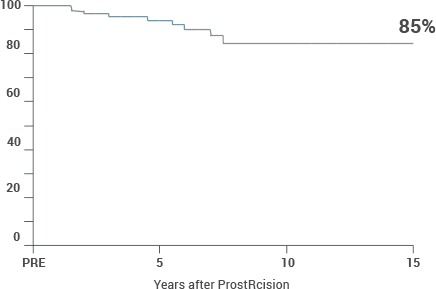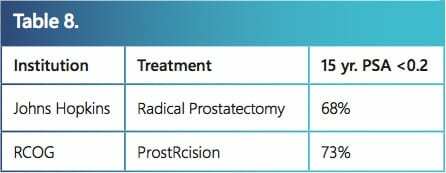An Individual Cure Rate (ICR) is the percentage that represents the likelihood of curing your prostate cancer based on our definition of cure. We define cure as having a PSA level of 0.2 ng/ml 10 years after treatment and remaining at that level consistently. Your ICR is based solely on your prostate cancer situation and is completely unique to you.
Example of an Individual Cure Rate probability produced for a man based on his cancer characteristics. Treated with ProstRcision, this man’s 15-year chance of zero PSA (below 0.2ng/ml) is 85%.

Simply ask your urologist or radiation oncologist for a 10-year ICR. If these physicians are unable to provide one, consider finding another doctor. And, be sure to ask about the size of the database used to calculate your cure rate. If the database is smaller than 2,000 men, the ICR is not much better than a guess.
While most doctors only talk about treating prostate cancer, our physicians specialize in curing it. The reason we are able to determine your Individual Cure Rate is that we keep a database with years of information (consisting of millions of data points) collected from more than 16,000 men before, during, and after treatment.
Once we learn more about your particular prostate cancer, we can compare it to the data from previous patients and determine your chance of being cured. We can provide your own Individual Cure Rate. Learn more about our study demonstrating ProstRcision’s high cure rate.
Our computerized prostate cancer database is a collection of medical information on all the 16,000+ men we have treated over the past three decades. On all men, we have collected pretreatment information such as their biopsy reports, including Gleason score, PSA, stage, etc. We then enter the radiation doses that we gave for treatment. Afterward, we follow up with the patient every six months for ten years and then once per year after that. A PSA test is completed, and urinary, rectal, and sexual function is monitored, and all are recorded into the database at each after-treatment follow-up visit.
Based on all of this data we’re able to determine the cure rate for individuals based on comparable patients and treatments.
There are two basic uses. 1) To write research papers for publication in medical journals such as the 25-year Report. 2) To analyze a man’s particular case of prostate cancer, such as yours, and calculate the chance of zero PSA at 10 years. The value of this database cannot be overstated. It is the key to our cancer program.
We are unique in the way that we maintain this database. With few exceptions, doctors who treat prostate cancer rarely have a database. For example, we are the only group with a database in Georgia that can calculate your 15 year chance of zero PSA, which is the single most important thing you want to know about your prostate cancer. Without a database, a doctor will not have insight or documentation of how well he cures prostate cancer or how many complications his patients have.
The Report mentioned in our program is a medical research paper from RCOG that was published in the Journal of Urology in March 2013 (JUrol 189:878:2013) that is entitled “25 Year Disease-Free Survival Rate After Radiation of Prostate Cancer Calculated With the Prostate-Specific Antigen Definition of Recurrence Used For Radical Prostatectomy.”
This report is particularly important because it is the first research paper that compares the treatment results of irradiation with those of Radical Prostatectomy calculated with an undetectable PSA of <0.2, or essentially a zero PSA for both treatments. Because it is so important, it was put in the title as to how the chance of men having an undetectable PSA was calculated. Although there have been literally thousands of papers published in medical journals comparing other treatments with Radical Prostatectomy since 1987, all are misleading for they compare Radical Prostatectomy calculated with a zero PSA with other treatments without any PSA goal. In other words, this 25-year report is the first apples-to-apples comparison of radiation with Radical Prostatectomy.
The chance of having PSA <0.2 fifteen years after treatment is given in the table displayed here: As you can see, the chance of a zero PSA 15 years after treatment is about the same. To get 15-year results, we analyzed men treated many years ago. Since then, there have been substantial improvements in treatment methods in both Radical Prostatectomy as well as the RCOG radiation program. Because of this, the chance of zero PSA in both programs, for men treated today, should be much higher than shown. It further showed the chance of a PSA <0.2 (zero PSA) is the same at 15, 20, and 25-year follow-up.

Quickly and efficiently build the materials you need to support your inbound marketing strategy. Drag and drop building blocks including testimonials, forms, calls-to-action, and more.